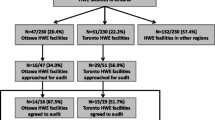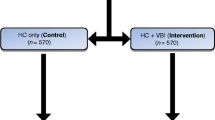ABSTRACT
BACKGROUND
Lack of regular physical activity is highly prevalent in U.S. adults and significantly increases mortality risk.
OBJECTIVE
To examine the clinical impact of a newly implemented program (“Exercise as a Vital Sign” [EVS]) designed to systematically ascertain patient-reported exercise levels at the beginning of each outpatient visit.
DESIGN AND PARTICIPANTS
The EVS program was implemented in four of 11 medical centers between April 2010 and October 2011 within a single health delivery system (Kaiser Permanente Northern California). We used a quasi-experimental analysis approach to compare visit-level and patient-level outcomes among practices with and without the EVS program. Our longitudinal observational cohort included over 1.5 million visits by 696,267 adults to 1,196 primary care providers.
MAIN MEASURES
Exercise documentation in physician progress notes; lifestyle-related referrals (e.g. exercise programs, nutrition and weight loss consultation); patient report of physician exercise counseling; weight change among overweight/obese patients; and HbA1c changes among patients with diabetes.
KEY RESULTS
EVS implementation was associated with greater exercise-related progress note documentation (26.2 % vs 23.7 % of visits, aOR 1.12 [95 % CI: 1.11–1.13], p < 0.001) and referrals (2.1 % vs 1.7 %; aOR 1.14 [1.11–1.18], p < 0.001) compared to visits without EVS. Surveyed patients (n = 6,880) were more likely to report physician exercise counseling (88 % vs. 76 %, p < 0.001). Overweight patients (BMI 25–29 kg/m2, n = 230,326) had greater relative weight loss (0.20 [0.12 – 0.28] lbs, p < 0.001) and patients with diabetes and baseline HbA1c > 7.0 % (n = 30,487) had greater relative HbA1c decline (0.1 % [0.07 %–0.13 %], p < 0.001) in EVS practices compared to non-EVS practices.
CONCLUSIONS
Systematically collecting exercise information during outpatient visits is associated with small but significant changes in exercise-related clinical processes and outcomes, and represents a valuable first step towards addressing the problem of inadequate physical activity.

Similar content being viewed by others
Explore related subjects
Discover the latest articles and news from researchers in related subjects, suggested using machine learning.REFERENCES
State-specific prevalence of no leisure-time physical activity among adults with and without doctor-diagnosed arthritis—United States, 2009 2011.
Tucker JM, Welk GJ, Beyler NK. Physical activity in U.S.: adults compliance with the physical activity guidelines for Americans. Am J Prev Med. 2011;40(4):454–461.
Willis BL, Gao A, Leonard D, Defina LF, Berry JD. Midlife fitness and the development of chronic conditions in later life. Arch Intern Med. 2012;27:1–8.
Vigen R, Ayers C, Willis B, DeFina L, Berry JD. Association of cardiorespiratory fitness with total, cardiovascular, and noncardiovascular mortality across 3 decades of follow-up in men and women. Circ Cardiovasc Qual Outcome. 2012;5(3):358–364.
Danaei G, Ding EL, Mozaffarian D, et al. The preventable causes of death in the United States: comparative risk assessment of dietary, lifestyle, and metabolic risk factors. PLoS Med. 2009;6(4):e1000058.
Anderson LH, Martinson BC, Crain AL, et al. Health care charges associated with physical inactivity, overweight, and obesity. Prev Chron Dis. 2005;2(4):A09.
Kahn EB, Ramsey LT, Brownson RC, et al. The effectiveness of interventions to increase physical activity. A systematic review. Am J Prev Med. 2002;22(4 Suppl):73–107.
Herring MP, Puetz TW, O'Connor PJ, Dishman RK. Effect of exercise training on depressive symptoms among patients with a chronic illness: a systematic review and meta-analysis of randomized controlled trials. Arch Intern Med. 2012;172(2):101–111.
Wen CP, Wai JP, Tsai MK, et al. Minimum amount of physical activity for reduced mortality and extended life expectancy: a prospective cohort study. Lancet. 2011;378(9798):1244–1253.
Leitzmann MF, Park Y, Blair A, et al. Physical activity recommendations and decreased risk of mortality. Arch Intern Med. 2007;167(22):2453–2460.
Lin JS, O'Connor E, Whitlock EP, Beil TL. Behavioral counseling to promote physical activity and a healthful diet to prevent cardiovascular disease in adults: a systematic review for the U.S. Preventive Services Task Force. Ann Intern Med. 2010;153(11):736–750.
Wee CC, McCarthy EP, Davis RB, Phillips RS. Physician counseling about exercise. JAMA. 1999;282(16):1583–1588.
Barnes PM, Schoenborn CA. Trends in adults receiving a recommendation for exercise or other physical activity from a physician or other health professional. NCHS Data Brief. 2012;86:1–8.
Glasgow RE, Eakin EG, Fisher EB, Bacak SJ, Brownson RC. Physician advice and support for physical activity: results from a national survey. Am J Prev Med. 2001;21(3):189–196.
Karter AJ, Moffet HH, Liu J, et al. Achieving good glycemic control: initiation of new antihyperglycemic therapies in patients with type 2 diabetes from the Kaiser Permanente Northern California diabetes registry. Am J Manag Care. 2005;11(4):262–270.
Zou G. A modified poisson regression approach to prospective studies with binary data. Am J Epidemiol. 2004;159(7):702–706.
Flegal KM, Carroll MD, Kit BK, Ogden CL. Prevalence of obesity and trends in the distribution of body mass index among US adults, 1999–2010. JAMA. 2012;307(5):491–497.
Coleman KJ, Ngor E, Reynolds K, et al. Initial validation of an exercise "vital sign" in electronic medical records. Med Sci Sports Exerc. 2012;44(11):2071–2076.
Wagner EH, Austin BT, Von Korff M. Organizing care for patients with chronic illness. Milbank Q. 1996;74(4):511–544.
Jha AK. Meaningful use of electronic health records: the road ahead. JAMA. 2010;304(15):1709–1710.
Grant RW, Middleton B. Improving primary care for patients with complex chronic diseases: can health information technology play a role? CMAJ. 2009;181(1–2):17–18.
Tang JW, Kushner RF, Cameron KA, Hicks B, Cooper AJ, Baker DW. Electronic tools to assist with identification and counseling for overweight patients: a randomized controlled trial. J Gen Intern Med. 2012;27(8):933–939.
Weiss DR, Wolfson C, Yaffe MJ, Shrier I, Puts MT. Physician counseling of older adults about physical activity: the importance of context. Am J Health Promot. 2012;27(2):71–74.
Phillips EM, Kennedy MA. The exercise prescription: a tool to improve physical activity. PM & R: J Inj Funct Rehab. 2012;4(11):818–825.
Calfas KJ, Long BJ, Sallis JF, Wooten WJ, Pratt M, Patrick K. A controlled trial of physician counseling to promote the adoption of physical activity. Prev Med. 1996;25(3):225–233.
Ostbye T, Yarnall KS, Krause KM, Pollak KI, Gradison M, Michener JL. Is there time for management of patients with chronic diseases in primary care? Ann Fam Med. 2005;3(3):209–214.
Bock C, Diehl K, Schneider S, Diehm C, Litaker D. Behavioral counseling for cardiovascular disease prevention in primary care settings: a systematic review of practice and associated factors. Med Care Res Rev. 2012;69(5):495–518.
Acknowledgements
This study was funded by the Centers for Disease Control and Prevention and the National Institute of Diabetes and Digestive and Kidney Diseases (NIDDK) (no. U58 DP002721) and by the Division of Research, Kaiser Permanente Northern California. RWG had full access to all of the data in the study and takes responsibility for the integrity of the data and the accuracy of the data analysis. Funders had no role in the design and conduct of the study; collection, management, analysis, and interpretation of the data; and preparation, review, or approval of the manuscript.
Conflict of Interest
The authors declare that they do not have a conflict of interest.
Author information
Authors and Affiliations
Corresponding author
APPENDIX
APPENDIX
The Keyword Search
Physician progress notes that included “EXERCI” (after excluding EXERCISE or EXERCISE-INDUCED or KEGEL EXERCISE or EXERCISE STRESS TEST) or “PHYSICAL ACTIV” or “PHYSICALLY ACTIV” or “LIFESTYLE MOD” or “LIFE STYLE MOD” or “LIFESTYLE CHANG” or “LIFE STYLE CHANG” or “HEALTHY LIFE”
Rights and permissions
About this article
Cite this article
Grant, R.W., Schmittdiel, J.A., Neugebauer, R.S. et al. Exercise as a Vital Sign: A Quasi-Experimental Analysis of a Health System Intervention to Collect Patient-Reported Exercise Levels. J GEN INTERN MED 29, 341–348 (2014). https://doi.org/10.1007/s11606-013-2693-9
Received:
Revised:
Accepted:
Published:
Issue Date:
DOI: https://doi.org/10.1007/s11606-013-2693-9




